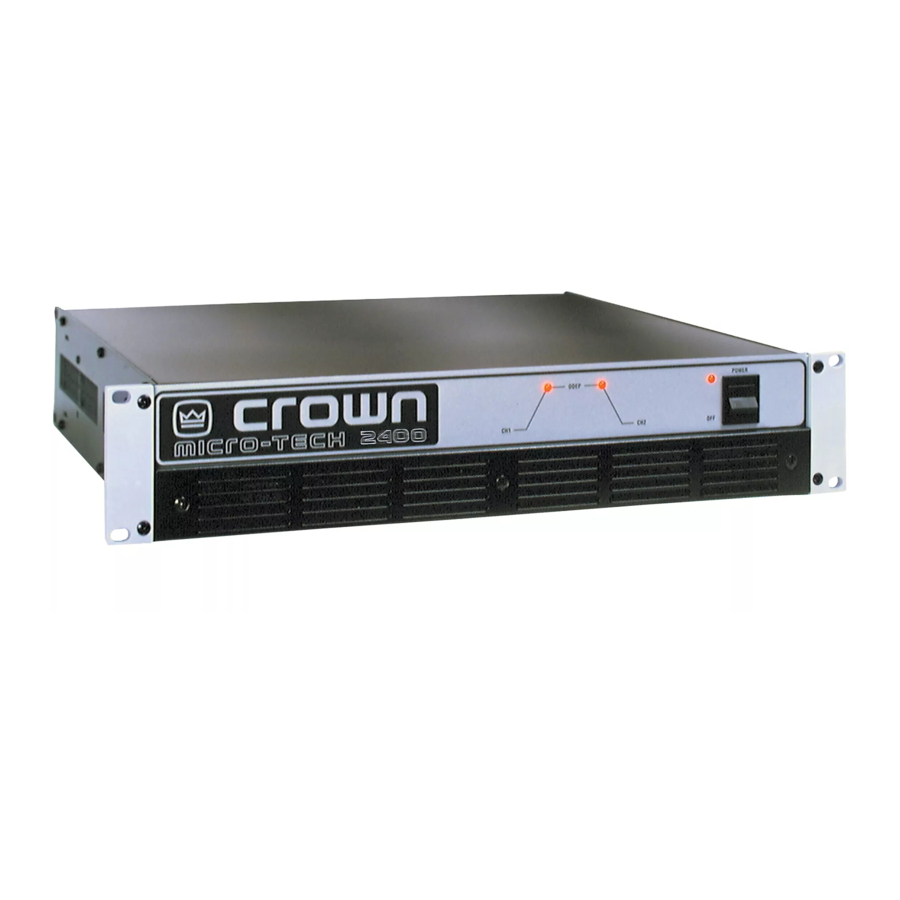
Crown Micro-Tech 1200 Service Manual
Hide thumbs
Also See for Micro-Tech 1200:
- Service manual (43 pages) ,
- Operation manual (28 pages) ,
- Reference manual (39 pages)
Advertisement
Quick Links
GENERAL INFORMATION
The following test procedures are to be used to verify
operation of this amplifier. DO NOT connect a load or
inject a signal unless directed to do so by the proce-
dure. These tests, though meant for verification and
alignment of the amplifier, may also be very helpful in
troubleshooting. For best results, tests should be
performed in order.
All tests assume that AC power is from a regulated 120
VAC source. Test equipment includes an oscilloscope,
a DMM, a signal generator, loads, and I.M.D. and
T.H.D. noise test equipment.
STANDARD INITIAL CONDITIONS
Level controls fully clockwise.
Stereo/Mono switch in Stereo.
Sensitivity switch in 26 dB fixed gain position.
It is assumed, in each step, that conditions of the
amplifier are per these initial conditions unless other-
wise specified.
TEST 1: DC OFFSET
Spec: 0 VDC, ±10 mV.
Initial Conditions: Controls per standard, inputs shorted.
Procedure: Measure DC voltage at the output connec-
tors (rear panel). There is no adjustment for output
offset. If spec is not met, there is an electrical malfunc-
tion. Slightly out of spec measurement is usually due to
U104/U204 out of tolorance.
TEST 2: OUTPUT BIAS ADJUSTMENT
Spec: 300 to 320 mVDC.
Initial Conditions: Controls per standard, heatsink tem-
perature less than 40°C.
Procedure: Measure DC voltages on the output module
across R02, adjust R26 if necessary. Measure DC
voltages on the output module across R21, adjust R23
if necessary. Repeat for second channel.
Micro-Tech 1200 Amplifier Service Manual
Electrical Checkout Procedures
TEST 3: ODEP VOLTAGE ADJUSTMENT
Spec: Bias Per Chart, ±0.1V DC.
Initial Conditions: Controls per standard, heatsink at
room temperature 20 to 30°C (68 to 86°F). Note: This
adjustment should normally be performed within 2
minutes of turn on from ambient (cold) conditions. If
possible measure heatsink temperature, if not measure
ambient room temperature. Use this information when
referencing the following chart. The following is a list of
ODEP bias voltages VS. temperature.
°F
°C
V
–ODEP
66
18.9
–10.31
68
20.0
–10.26
70
21.1
–10.20
72
22.2
–10.14
74
23.3
–10.09
76
24.4
–10.03
77
25.0
–10.00
78
25.6
–9.97
80
26.7
–9.91
82
27.8
–9.86
84
28.9
–9.80
86
30.0
–9.74
88
31.1
–9.69
90
32.2
–9.63
92
33.3
–9.57
94
34.4
–9.51
–ODEP Procedure: Measure pin 6 of U100 and, if neces-
sary, adjust R121 to obtain V
Measure pin 6 of U200 and, if necessary, adjust R221
to obtain V
as specified above.
–ODEP
+ODEP Procedure: Measure pin 6 of U103 and, if neces-
sary, adjust R132 to obtain V
Measure pin 6 of U203 and, if necessary, adjust R232
to obtain V
as specified above.
+ODEP
V
+ODEP
11.41
11.36
11.30
11.24
11.19
11.13
11.10
11.07
11.01
10.96
10.90
10.84
10.79
10.73
10.67
10.61
as specified above.
–ODEP
as specified above.
+ODEP
13
Advertisement

Summary of Contents for Crown Micro-Tech 1200
- Page 1 Micro-Tech 1200 Amplifier Service Manual Electrical Checkout Procedures GENERAL INFORMATION TEST 3: ODEP VOLTAGE ADJUSTMENT The following test procedures are to be used to verify Spec: Bias Per Chart, ±0.1V DC. operation of this amplifier. DO NOT connect a load or...
- Page 2 Micro-Tech 1200 Amplifier Service Manual Electrical Checkout Procedures TEST 4: AC POWER DRAW Spec: Level controlled by level controls. Initial Conditions: Controls per standard. Spec: 100 Watts maximum quiescent. Procedure: No Load. Inject a 1 kHz sine wave. With level Initial Conditions: Controls per standard.
- Page 3 Micro-Tech 1200 Amplifier Service Manual Electrical Checkout Procedures Spec at 4 Ohm Stereo: >= 470W at 0.1% THD. Spec at 2 Ohm Stereo: >= 600W at 0.1% THD. International 8 Ohm Stereo: >=305W at 0.1% THD. International 4 Ohm Stereo: >=430W at 0.1% THD.
- Page 4 Micro-Tech 1200 Amplifier Service Manual Electrical Checkout Procedures Spec: No dangerous transients. Initial Conditions: Controls per standard. Procedure: From an on condition, turn off the amplifier and monitor the output noise at the time of turn off. Note: Turn off noise may increase significantly if the amplifier is cycled off and on.











